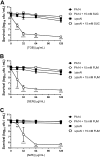Potentiation of Aminoglycoside Lethality by C4-Dicarboxylates Requires RpoN in Antibiotic-Tolerant Pseudomonas aeruginosa
- PMID: 31383655
- PMCID: PMC6761562
- DOI: 10.1128/AAC.01313-19
Potentiation of Aminoglycoside Lethality by C4-Dicarboxylates Requires RpoN in Antibiotic-Tolerant Pseudomonas aeruginosa
Abstract
Antibiotic tolerance contributes to the inability of standard antimicrobial therapies to clear the chronic Pseudomonas aeruginosa lung infections that often afflict patients with cystic fibrosis (CF). Metabolic potentiation of bactericidal antibiotics with carbon sources has emerged as a promising strategy to resensitize tolerant bacteria to antibiotic killing. Fumarate (FUM), a C4-dicarboxylate, has been recently shown to resensitize tolerant P. aeruginosa to killing by tobramycin (TOB), an aminoglycoside antibiotic, when used in combination (TOB+FUM). Fumarate and other C4-dicarboxylates are taken up intracellularly by transporters regulated by the alternative sigma factor RpoN. Once in the cell, FUM is metabolized, leading to enhanced electron transport chain activity, regeneration of the proton motive force, and increased TOB uptake. In this work, we demonstrate that a ΔrpoN mutant displays impaired FUM uptake and, consequently, nonsusceptibility to TOB+FUM treatment. RpoN was also found to be essential for susceptibility to other aminoglycoside and C4-dicarboxylate combinations. Importantly, RpoN loss-of-function mutations have been documented to evolve in the CF lung, and these loss-of-function alleles can also result in TOB+FUM nonsusceptibility. In a mixed-genotype population of wild-type and ΔrpoN cells, TOB+FUM specifically killed cells with RpoN function and spared the cells that lacked RpoN function. Unlike C4-dicarboylates, both d-glucose and l-arginine were able to potentiate TOB killing of ΔrpoN stationary-phase cells. Our findings raise the question of whether TOB+FUM will be a suitable treatment option in the future for CF patients infected with P. aeruginosa isolates that lack RpoN function.
Keywords: Pseudomonas aeruginosa; antibiotic tolerance; fumarate; metabolic potentiation; rpoN; tobramycin.
Copyright © 2019 American Society for Microbiology.
Figures








Similar articles
-
A mini-review: environmental and metabolic factors affecting aminoglycoside efficacy.World J Microbiol Biotechnol. 2022 Nov 9;39(1):7. doi: 10.1007/s11274-022-03445-8. World J Microbiol Biotechnol. 2022. PMID: 36350431 Free PMC article. Review.
-
An Antipersister Strategy for Treatment of Chronic Pseudomonas aeruginosa Infections.Antimicrob Agents Chemother. 2017 Nov 22;61(12):e00987-17. doi: 10.1128/AAC.00987-17. Print 2017 Dec. Antimicrob Agents Chemother. 2017. PMID: 28923873 Free PMC article.
-
Rapid Freezing Enables Aminoglycosides To Eradicate Bacterial Persisters via Enhancing Mechanosensitive Channel MscL-Mediated Antibiotic Uptake.mBio. 2020 Feb 11;11(1):e03239-19. doi: 10.1128/mBio.03239-19. mBio. 2020. PMID: 32047133 Free PMC article.
-
RpoN Modulates Carbapenem Tolerance in Pseudomonas aeruginosa through Pseudomonas Quinolone Signal and PqsE.Antimicrob Agents Chemother. 2016 Sep 23;60(10):5752-64. doi: 10.1128/AAC.00260-16. Print 2016 Oct. Antimicrob Agents Chemother. 2016. PMID: 27431228 Free PMC article.
-
PEGylation of Tobramycin Improves Mucus Penetration and Antimicrobial Activity against Pseudomonas aeruginosa Biofilms in Vitro.Mol Pharm. 2018 Apr 2;15(4):1643-1652. doi: 10.1021/acs.molpharmaceut.8b00011. Epub 2018 Mar 13. Mol Pharm. 2018. PMID: 29514003
Cited by
-
Deficiency in cytosine DNA methylation leads to high chaperonin expression and tolerance to aminoglycosides in Vibrio cholerae.PLoS Genet. 2021 Oct 20;17(10):e1009748. doi: 10.1371/journal.pgen.1009748. eCollection 2021 Oct. PLoS Genet. 2021. PMID: 34669693 Free PMC article.
-
A Dietary Source of High Level of Fluoroquinolone Tolerance in mcr-Carrying Gram-Negative Bacteria.Research (Wash D C). 2023 Oct 6;6:0245. doi: 10.34133/research.0245. eCollection 2023. Research (Wash D C). 2023. PMID: 37808177 Free PMC article.
-
The antimicrobial peptide LI14 combats multidrug-resistant bacterial infections.Commun Biol. 2022 Sep 7;5(1):926. doi: 10.1038/s42003-022-03899-4. Commun Biol. 2022. PMID: 36071151 Free PMC article.
-
Aminoglycoside uptake, stress, and potentiation in Gram-negative bacteria: new therapies with old molecules.Microbiol Mol Biol Rev. 2023 Dec 20;87(4):e0003622. doi: 10.1128/mmbr.00036-22. Epub 2023 Dec 4. Microbiol Mol Biol Rev. 2023. PMID: 38047635 Free PMC article. Review.
-
A mini-review: environmental and metabolic factors affecting aminoglycoside efficacy.World J Microbiol Biotechnol. 2022 Nov 9;39(1):7. doi: 10.1007/s11274-022-03445-8. World J Microbiol Biotechnol. 2022. PMID: 36350431 Free PMC article. Review.
References
-
- Ramsey BW, Pepe MS, Quan JM, Otto KL, Montgomery AB, Williams-Warren J, Vasiljev-K M, Borowitz D, Bowman CM, Marshall BC, Marshall S, Smith AL. 1999. Intermittent administration of inhaled tobramycin in patients with cystic fibrosis. N Engl J Med 340:23–30. doi:10.1056/NEJM199901073400104. - DOI - PubMed
-
- Smith WD, Bardin E, Cameron L, Edmondson CL, Farrant KV, Martin I, Murphy RA, Soren O, Turnbull AR, Wierre-Gore N, Alton EW, Bundy JG, Bush A, Connett GJ, Faust SN, Filloux A, Freemont PS, Jones AL, Takats Z, Webb JS, Williams HD, Davies JC. 2017. Current and future therapies for Pseudomonas aeruginosa infection in patients with cystic fibrosis. FEMS Microbiol Lett 364:fnx121. doi:10.1093/femsle/fnx121. - DOI - PubMed
Publication types
MeSH terms
Substances
Grants and funding
LinkOut - more resources
Full Text Sources
Medical

